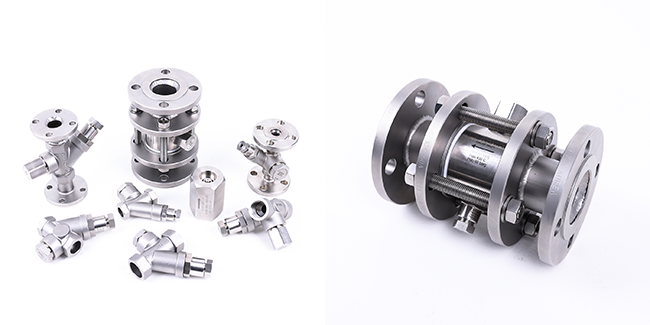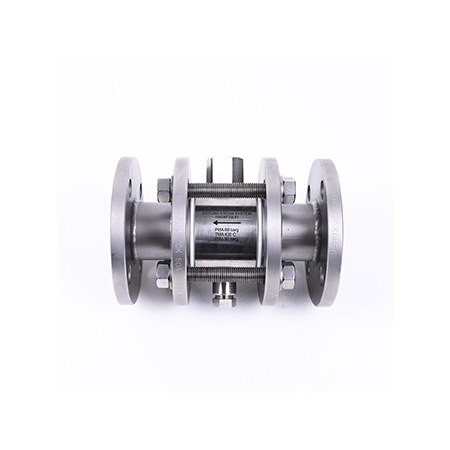The center of energy-saving solutions!
Products


DST Steam Trap
In order to develop a localized steam trap that has accumulated excellent technology to solve durability problems such as live steam loss, frequent breakdowns and wear and tear of mechanical steam traps such as volumetric, bucket, and disk, thermodyne types, it was developed by investing in a purchasecontingent R&D project by the Ministry of SMEs and Startups and Korea Southeast Power Co.
DST steam traps are optimized steam traps that deliver energy savings, reliability for steam systems and reduced maintenance costs
Venturi type nozzle actively responds to the amount of condensate!
Immediate, continuous, and complete removal of condensate from production facilities, piping systems, heat exchangers, etc. that run on steam!
Realizes effective steam loss reduction in energy lines that use steam as a heat source!
-

Maintaining Steam Temperature
Increase thermal efficiencyImproves steam temperature retention and thermal efficiency in processes that use steam as a heat source by enabling immediate, continuous, and complete evacuation of condensate in the steam.
-

Enhanced durability
Reduced maintenance costsBuilt-in strainer and blow valve integrated into the body of the steam trap itself, it is easy to remove foreign substances such as scale and maintain durability for more than 15 years.
-

Eliminate excessive safety factors Reduce vapor losses by 20% or more
Continuous operation through venturi type nozzle designed and sized individually for each site to discharge condensate rather than mechanical intermittent operation.
-

Reduced costs such as water and electricity
Prevention of environmental pollution such as carbon emission reductionReduces leakage of live steam, reduces incidental costs such as water and electricity, reduces condensate emissions and prevents environmental pollution by reducing carbon emissions
Technical Differences of
DST Steam Traps
DST Steam Traps
 Structure
Structure-
Construction and Basic Principles
좌우로 스크롤 하시면
내용이 보입니다.Mechanical/Thermodynamic
Steam TrapsDST Steam Trap Depending on the temperature, pressure, and water surface difference in the drain, the ball/bucket/bimetal inside the steam trap moves and the mechanical opening and closing of the connected valve discharges the condensate. Using the density difference of steam and condensate of 1:1000, condensate is continuously discharged through a venturi type nozzle (0.2~18㎜) without mechanical operation.
 Distinction
Distinction-
Technical Differentiation
Condensate Drainage
좌우로 스크롤 하시면
내용이 보입니다.Mechanical/Thermodynamic
Steam TrapsDST Steam Trap Intermittent discharge by mechanical opening and closing of valves (ON/OFF method) Automatic, continuous, always-on evacuation via venturi nozzle Steam + condensate leakage (at 10 bar)
좌우로 스크롤 하시면
내용이 보입니다.Mechanical/Thermodynamic
Steam TrapsDST Steam Trap For 3/4″ steam trap (2㎜ orifice), 160kg/hr of condensate is generated According to the structure and basic principle of steam saturation temperature and pressure, steam traps are generally manufactured according to the saturation temperature and pressure of steam, and excessive safety factors are set on the orifice to apply them in batches at the production site (usually a safety factor of 1.5~5 times is applied). 3/4″ steam trap (0.4㎜ nozzle) generates 6.4kg/hr of condensate Predict the amount of condensate generated by thermal change of steam in production and piping facilities, heat exchangers, etc. operated with steam, and size the nozzle according to the amount of condensate generated (avoiding excessive safety factor) Water Hammering & Freezing
좌우로 스크롤 하시면
내용이 보입니다.Mechanical/Thermodynamic
Steam TrapsDST Steam Trap Intermittent valve opening and closing causes some residual phenomena Continuous discharge eliminates symptoms Durability
좌우로 스크롤 하시면
내용이 보입니다.Mechanical/Thermodynamic
Steam TrapsDST Steam Trap Durability is low (1 to 5 years) due to the entire component is usually made of cast iron, and the mechanical moving parts are subjected to repetitive operation, and the durability is less than 1 year in sites with high load fluctuations due to heat exchange. All components are made of stainless steel castings (SUS304/316), and there are no mechanical moving parts that operate repeatedly in structure and principle, so durability is high (15 years or more) Strainer
좌우로 스크롤 하시면
내용이 보입니다.Mechanical/Thermodynamic
Steam TrapsDST Steam Trap Separately configured to protect the function of the steam trap on the shear side of the steam trap, and requires installation and maintenance costs. Made of stainless steel with a screen of 80 mesh or more, it is integrated into the condensate accumulation pipe of the steam trap, so no separate installation and maintenance costs are incurred. Blow valve
좌우로 스크롤 하시면
내용이 보입니다.Mechanical/Thermodynamic
Steam TrapsDST Steam Trap The steam trap itself or the strainer installed on the shear side is not configured with a blow valve, and it is difficult to maintain the normal function of the steam trap and strainer unless the facility personnel periodically dismantle and disassemble the steam trap and strainer from the steam pipe for maintenance work, and the durability of the steam pipe and steam trap is shortened. It is configured to be easily opened and closed as an integrated unit at the bottom of the condensate accumulation pipe of the steam trap, so it is easy to remove scale, oxidants, and contaminants in the steam pipe using the steam pressure of the accumulation pipe without dismantling or disassembling the steam trap or strainer, and contributes to maintaining the function and increasing the durability of the steam pipe and steam trap.
 Energy
Energy-
Reduce energy costs (LNG/coal/wood pellet,steam)
Reduce carbon footprint좌우로 스크롤 하시면
내용이 보입니다.Mechanical/Thermodynamic
Steam TrapsDST Steam Trap The steam trap itself is subjected to frequent failures and wear and tear due to repeated operation of the mechanical moving parts to discharge condensate, resulting in excessive steam losses and increased energy (LNG/coal/wood pellets, etc.) costs. Since steam traps have steam working pressure, steam losses due to unexpected failure and aging of steam traps are quite large. As of March 2022, the unit cost of production and supply per ton of steam was KRW 40,000 on average, but as of December 2022, it was over KRW 80,000 on average. Since the steam trap itself has no mechanically repetitive moving parts to discharge condensate, there is no aging due to failure and wear and tear, and by predicting the amount of condensate generated by the thermal change of steam in steam-operated production, piping facilities, heat exchangers, etc. and sizing the nozzle individually customized for each site, it has been demonstrated that steam losses can be reduced by more than 20% compared to conventional steam traps.
 Reduce
Reduce-
Reduce Production Rejects
좌우로 스크롤 하시면
내용이 보입니다.Mechanical/Thermodynamic
Steam TrapsDST Steam Trap Since it adopts a mechanical valve opening and closing (ON/OFF) method that operates intermittently only when a certain amount of condensate is stored, uneven process heating temperature (hunting) occurs immediately after discharging the condensate, resulting in defective products. Since the condensate is discharged continuously, the process heating temperature is equalized and no defective products are produced.
 Cost
Cost-
Reduce maintenance costs
좌우로 스크롤 하시면
내용이 보입니다.Mechanical/Thermodynamic
Steam TrapsDST Steam Trap Due to the repeated operation of the mechanical moving part for discharging condensate composed of the steam trap itself, frequent breakdowns and aging due to wear and tear, rust problems due to cast iron castings, and separate installation of strainers, frequent replacement and maintenance of steam piping facilities and steam traps are required, increasing the number of management points for facility personnel and increasing fixed maintenance costs. The steam trap itself has no mechanically repetitive moving parts for condensate discharge, eliminating aging due to breakdown and wear and tear; it is made of 100% stainless steel (SUS304/316), eliminating rust problems; and the steam trap itself has an integrated strainer and brow valve to easily discharge scale, oxidants, and contaminants generated in the steam piping. This eliminates the need for frequent replacement and maintenance of steam piping facilities and steam traps such as strainers, and reduces maintenance costs while maintaining the durability and initial performance of the steam trap for more than 15 years.










